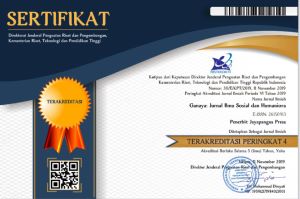Perancangan Visual Dalam Kampanye Edukasi Efisiensi Listrik Dengan Program Listrik Pintar Dari PT PLN Persero
DOI:
https://doi.org/10.37329/ganaya.v8i2.4227Keywords:
Efficiency, Electricity, Sustainability, PLN, SmartAbstract
The presence of electricity has become a primary necessity in modern life; however, increasing electricity consumption poses a major challenge for national energy providers such as PT PLN (Persero). The Listrik Pintar (Smart Electricity) program, a prepaid service by PLN, is designed to help customers manage their electricity usage more efficiently. This study aims to design a social media-based educational campaign via Instagram to raise awareness among Generation Z regarding electricity efficiency through the Listrik Pintar program in Medan, one of Indonesia's major cities. Using the ADDIE method (Analysis, Design, Development, Implementation, Evaluation), the study develops systematic and flexible visual educational media. Data was collected through interviews with PLN employees, Generation Z respondents, and social media strategists, as well as questionnaires, observation, and documentation. The WattWise campaign, employing a flat design visual style and an owl mascot, was implemented through the Instagram account @wattwise.id for one month. Evaluation results show a high validity score of 86% based on the Validator Evaluation Design, covering aspects of graphics, presentation, language, and context. The N-Gain effectiveness test yielded a score of 1.5, indicating high effectiveness in material delivery, with respondents’ understanding increasing from an average pre-test score of 60 to a post-test score of 90. In conclusion, this campaign proved to be both valid and effective in enhancing Generation Z's awareness of electricity efficiency and in supporting the Listrik Pintar program. The novelty of this research lies in the use of Instagram as a platform for electricity efficiency education, a field that has not yet been widely explored, with potential for further development in content and integration of Listrik Pintar program information.
References
Ayuningtyas, W. D., Fitriyani, D., Nurfajri, I., & Purwanto, E. (2025). Peran Media Sosial Dalam Meningkatkan Kesadaran Lingkungan Di Kalangan Milenial. Pubmedia Social Sciences and Humanities, 2(3), 1–0.
Direktorat Analisis dan Pengembangan Statistik. (2024). Indikator Tujuan Pembangunan Berkelanjutan Indonesia (Vol. 8; Direktorat Analisis dan Pengembangan Statistik, Ed.). Jakarta: Badan Pusat Statistik.
Hariyanto, B. (2021). Energy Efficiency: The Manufacturing Sector in Indonesia. JEJAK, 14(2), 200–217.
Hartati, S., Niah, S., Arisandi, D., & Asnawi, M. (2024). Edukasi Literasi Hemat Energi Dalam Pendidikan Sebagai Upaya Mengurangi Dampak Negatif Teknologi. Jurnal Pengabdian Masyarakat Bangsa, 2(10), 4464–4469.
Hasna, D. P., & Budiwaspada, A. E. (2023). Strategi Perancangan Kampanye Digital Pemberdayaan Perempuan Rawan Sosial Ekonomi Di Kota Bandung. Visual Heritage: Jurnal Kreasi Seni dan Budaya, 06(03), 558–570.
Hidayat, Z., & Hidayat, D. (2020). Environmental Sense of Gen Z in Online Communities: Exploring the Roles of Sharing Knowledge and Social Movement on Instagram. BIS-HSS. Jakarta: European Alliance for Innovation.
Junaidi, A., & Syaifulrahman, B. (2022). Strategi Komunikasi Penggunaan Instagram dalam Meningkatkan Kesadaran Masyarakat akan Krisis Iklim. Jurnal Koneksi, 6(2), 416–423.
Nugraheni, A. S., Pratiwi, N. M. I., & Mulyati, A. (2023). Pengaruh Lingkungan, Kepercayaan Diri, dan Motivasi Terhadap Minat Berwirausaha Pada Generasi Z Di Kecamatan Tambaksari Surabaya. Jurnal Sosialita, 2(2), 388–402.
Pfadt-Trilling, A. R., Volk, T. A., & Fortier, M. O. P. (2021). Climate Change Impacts of Electricity Generated at a Waste-to-Energy Facility. Environmental Science and Technology, 55(3), 1436–1445.
Pinalis, D., Triyono, A., & Yulianto, L. (2024). Pemahaman Gen Z Terhadap Tindakan Cyberbullying Di Platform Instagram. Jurnal Common, 8(2), 178–192.
PT PLN. (2023). Laporan Statistik PLN 2023. In PT PLN (Ed.), PT PLN. Jakarta: PT PLN.
Rahmi, S. S., & Muchlis, F. R. (2025). Pengaruh Media Sosial terhadap Efektivitas Kampanye Sosialisasi Kesehatan di Era Digital. Jurnal Penelitian Komunikasi Dan Sosialisasi, 1(1), 15–20.
Riani, Amril, & Amzar, Y. V. (2022). Analisis Permintaan Listrik Rumah Tangga Perkotaan Dan Pedesaan Di Provinsi Jambi (Studi Komparatif Dan Faktor-Faktor yang Mempengaruhinya). e-Jurnal Ekonomi Sumberdaya dan Lingkungan, 11(3), 2303–1220.
Ryanda, M. (2024). Strategi Peningkatan Literasi Media Pada Gen Z Di Indonesia. Retorika, 1(7), 88–95.
Saadah, N. N., Yusuf, I., & Budiman, A. (2023). Analisis Pemasaran Digital Menggunakan Model Aisas Pada Produk Semakin Peka. Jurnal Ilmiah JIMEA, 7(2), 1153–1164.
Sisdwinugraha, P., Hapsari, A., & Padhilah, F. A. (2025). Imprint Indonesia Energy Transition Outlook 2025 Navigating Indonesia’s Energy Transition at the Crossroads: A Pivotal Moment for Redefining the Future. Imprint Indonesia Energy Transition Outlook, 5, 2025. Jakarta: IESR.
Tanjung, A., Setiawan, D., & Hamzah. (2021). Penerapan Persyaratan Umum Instalasi Listrik dan Standarisasi Kelistrikan di Kelurahan Maharani Kecamatan Rumbai. Jurnal Unilak, 2(1), 32–38.
Downloads
Published
How to Cite
Issue
Section
License
Copyright (c) 2025 Muhammad Fathi Fadhil Fauzi Rizal, Taufik Murtono (Author)

This work is licensed under a Creative Commons Attribution-ShareAlike 4.0 International License.
An author who publishes in the Ganaya : Jurnal Ilmu Sosial dan Humaniora agrees to the following terms:
- Author retains the copyright and grants the journal the right of first publication of the work simultaneously licensed under the Creative Commons Attribution-ShareAlike 4.0 License that allows others to share the work with an acknowledgement of the work's authorship and initial publication in this journal
- Author is able to enter into separate, additional contractual arrangements for the non-exclusive distribution of the journal's published version of the work (e.g., post it to an institutional repository or publish it in a book) with the acknowledgement of its initial publication in this journal.
- Author is permitted and encouraged to post his/her work online (e.g., in institutional repositories or on their website) prior to and during the submission process, as it can lead to productive exchanges, as well as earlier and greater citation of the published work (See The Effect of Open Access).
Read more about the Creative Commons Attribution-ShareAlike 4.0 Licence here: https://creativecommons.org/licenses/by-sa/4.0/.








